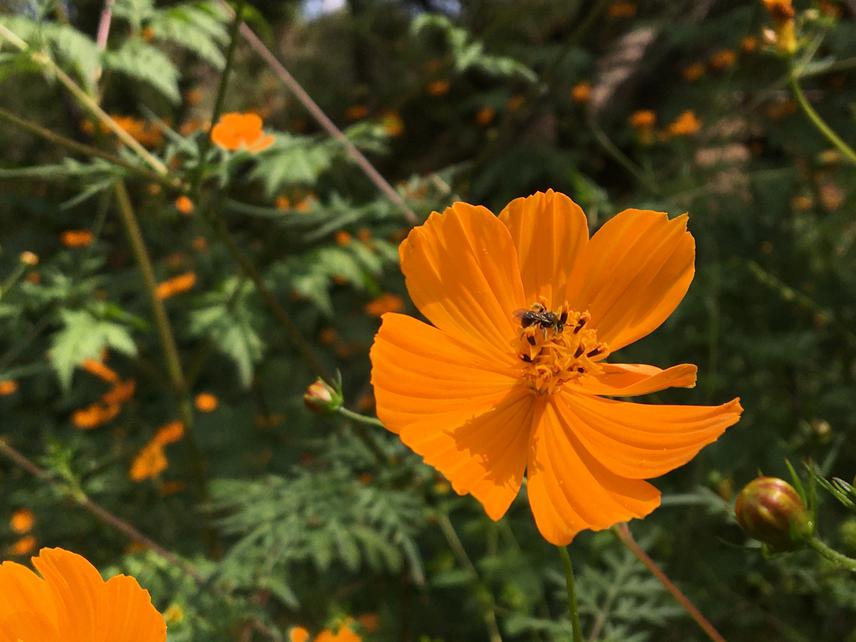Social media video featuring the project.
Conservación de interacciones plantas-abejas nativas en paisajes de agricultura intensiva
25 May 2022 Lake Chapala, Mexico, Central and Latin America Invertebrates | Communities | Farming | Plants
Scaling Up to Conservation Guidelines: Lake Chapala Basin Wild Bee-Plant Interaction Network Conservation Project
The pollination service wild bees provide is increasingly valued. However, we don’t have enough information on the majority of wild-bee species to evaluate their possible vulnerability-state to be listed on conservation categories. Effective wild-bee conservation implies considering the landscapes’ human-dimension to protect and restore their habitats. This is relevant in Neotropical ecosystems, which have a high biodiversity-level and high anthropogenic demand for land-use. Hence, we focus on establishing baseline research for the conservation of wild-bee communities in intensive-agriculture landscapes, Lake Chapala basin, Mexico, using taxonomic and functional interaction-networks approach, considering the human-dimension shaping landscapes we need for food safety. The work is framed within hypotheses proposed by Tscharntke et al. (2012), providing critical knowledge for biodiversity-management, ecosystems, and their services at landscape-scale.
This project will be carried out in a portion of Lake Chapala basin, covering an elevation range between 1500 and 1800 masl; lower left corner: 19.948921, -103.67155275919342; right upper corner: 20.6113, -102.48868753976416. Lake Chapala centroid at: 20.236339, -103.02010501280857) Lerma-Chapala-Santiago sub-basins are some of the most important water exploitation areas in the region, which supplies Guadalajara Metropolitan Area, one of the largest urban areas in Mexico.

Halictus bee on Cosmos sulphureus flower. © Luis R. Mtz. G.
Sampling-sites cover about 25,131.07 hectares of intensive agricultural areas belonging to 11 different municipalities: 9 from Jalisco, and from Michoacán.
The Lake Chapala basin is catalogued by the National Commission for the Knowledge and Use of Biodiversity (CONABIO) as a priority terrestrial region for conservation of biodiversity, highlighting the presence of threatened and vulnerable species, ecosystem richness, and significant biological integrity. Nonetheless, the Lake Chapala basin has a long social history of land-use, and of socio-environmental issues such as water pollution, over-exploitation of aquifers, labour exploitation, deterioration of public health, and many others associated with the decline of nature. Two Protected Areas are located in the northern part of the Chapala Lake basin: Cerro Viejo-Chupinaya-Los sabinos, and Sierra Cóndiro-Canales y Cerro San Miguel-Chiquihuitillo, both with a protection category at the Mexican-state level. None of the sampling-sites are within the protected-areas.
This project is highly relevant because: i) wild bees are associated with key-ecosystem-services for the maintenance of wild-plant diversity, ecosystem-stability and food production, which guarantee food security (Klein et al., 2007; Patel et al., 2021), ii) there are few works on landscape-scale about wild-bee communities in neotropics, iii) none of these studies considers landscape-attributes from an environmental territorial perspective, iv) none have been done in neotropics-central-western zone, Mexico, v) studies evaluating the effect of landscape-attributes on taxonomic-functional-structure of wild bee communities have not considered the approach of ecological interaction networks.
Bibliography
Klein, A. M., Vaissière, B. E., Cane, J. H., Steffan-Dewenter, I., Cunningham, S. A., Kremen, C., & Tscharntke, T. (2007). Importance of pollinators in changing landscapes for world crops. In Proceedings of the Royal Society B: Biological Sciences (Vol. 274, Issue 1608, pp. 303–313). Royal Society. https://doi.org/10.1098/rspb.2006.3721
Patel, V., Pauli, N., Biggs, E., Barbour, L., & Boruff, B. (2021). Why bees are critical for achieving sustainable development. Ambio, 50(1), 49–59. https://doi.org/https://doi.org/10.1007/s13280-020-01333-9
Tscharntke, T., Tylianakis, J. M., Rand, T. A., Didham, R. K., Fahrig, L., Batáry, P., Bengtsson, J., Clough, Y., Crist, T. O., Dormann, C. F., Ewers, R. M., Fründ, J., Holt, R. D., Holzschuh, A., Klein, A. M., Kleijn, D., Kremen, C., Landis, D. A., Laurance, W., … Westphal, C. (2012). Landscape moderation of biodiversity patterns and processes - eight hypotheses. Biological Reviews, 87(3), 661–685. https://doi.org/10.1111/j.1469-185X.2011.00216.x
Header: Native bee of the genus Andrena. © Luis R. Mtz. G.
Social media video featuring the project.
Conservación de interacciones plantas-abejas nativas en paisajes de agricultura intensiva